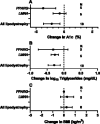This is a preprint.
Systematic review of genotype-stratified treatment for monogenic insulin resistance
- PMID: 37205502
- PMCID: PMC10187355
- DOI: 10.1101/2023.04.17.23288671
Systematic review of genotype-stratified treatment for monogenic insulin resistance
Update in
-
Genotype-stratified treatment for monogenic insulin resistance: a systematic review.Commun Med (Lond). 2023 Oct 5;3(1):134. doi: 10.1038/s43856-023-00368-9. Commun Med (Lond). 2023. PMID: 37794082 Free PMC article.
Abstract
Objective: To assess the effects of pharmacologic and/or surgical interventions in monogenic insulin resistance (IR), stratified by genetic aetiology.
Design: Systematic review.
Data sources: PubMed, MEDLINE and Embase, from 1 January 1987 to 23 June 2021.
Review methods: Studies reporting individual-level effects of pharmacologic and/or surgical interventions in monogenic IR were eligible. Individual subject data were extracted and duplicate data removed. Outcomes were analyzed for each affected gene and intervention, and in aggregate for partial, generalised and all lipodystrophy.
Results: 10 non-randomised experimental studies, 8 case series, and 21 single case reports met inclusion criteria, all rated as having moderate or serious risk of bias. Metreleptin was associated with lower triglycerides and hemoglobin A1c in aggregated lipodystrophy (n=111), in partial lipodystrophy (n=71) and generalised lipodystrophy (n=41)), and in LMNA , PPARG , AGPAT2 or BSCL2 subgroups (n=72,13,21 and 21 respectively). Body Mass Index (BMI) was lower after treatment in partial and generalised lipodystrophy overall, and in LMNA or BSCL2 , but not PPARG or AGPAT2 subgroups. Thiazolidinedione use was associated with improved hemoglobin A1c and triglycerides in aggregated lipodystrophy (n=13), improved hemoglobin A1c only in the PPARG subgroup (n=5), and improved triglycerides only in the LMNA subgroup (n=7). In INSR -related IR, use of rhIGF-1, alone or with IGFBP3, was associated with improved hemoglobin A1c (n=15). The small size or absence of all other genotype-treatment combinations precluded firm conclusions.
Conclusions: The evidence guiding genotype-specific treatment of monogenic IR is of low to very low quality. Metreleptin and Thiazolidinediones appear to have beneficial metabolic effects in lipodystrophy, and rhIGF-1 appears to lower hemoglobin A1c in INSR-related IR. For other interventions there is insufficient evidence to assess efficacy and risks either in aggregated lipodystrophy or in genetic subgroups. There is a pressing need to improve the evidence base for management of monogenic IR.
Conflict of interest statement
Authors’ declaration of personal interests
R.K.S. has received speaker fees from Eli Lilly, Novo Nordisk, and Amryt. R. J. B. has received research support from Amryt, Third Rock Ventures, Ionis, and Regeneron. K.A.P. and S.A. report no conflicts of interest.
Figures




References
-
- Bonnefond A. & Semple R. K. Achievements, prospects and challenges in precision care for monogenic insulin-deficient and insulin-resistant diabetes. Diabetologia 65, 1782–1795 (2022). https://doi.org:10.1007/s00125-022-05720-7 - DOI - PMC - PubMed
-
- Lim K., Haider A., Adams C., Sleigh A. & Savage D. B. Lipodistrophy: a paradigm for understanding the consequences of “overloading” adipose tissue. Physiol Rev 101, 907–993 (2021). https://doi.org:10.1152/physrev.00032.2020 - DOI - PubMed
-
- Semple R. K., Savage D. B., Cochran E. K., Gorden P. & O’Rahilly S. Genetic syndromes of severe insulin resistance. Endocr Rev 32, 498–514 (2011). https://doi.org:10.1210/er.2010-0020 - DOI - PubMed
-
- Gonzaga-Jauregui C. et al. Clinical and Molecular Prevalence of Lipodystrophy in an Unascertained Large Clinical Care Cohort. Diabetes 69, 249–258 (2020). https://doi.org:10.2337/db19-0447 - DOI - PubMed
-
- Brown R. J. et al. The Diagnosis and Management of Lipodystrophy Syndromes: A Multi-Society Practice Guideline. J Clin Endocrinol Metab 101, 4500–4511 (2016). https://doi.org:10.1210/jc.2016-2466 - DOI - PMC - PubMed
Publication types
Grants and funding
LinkOut - more resources
Full Text Sources
Miscellaneous
